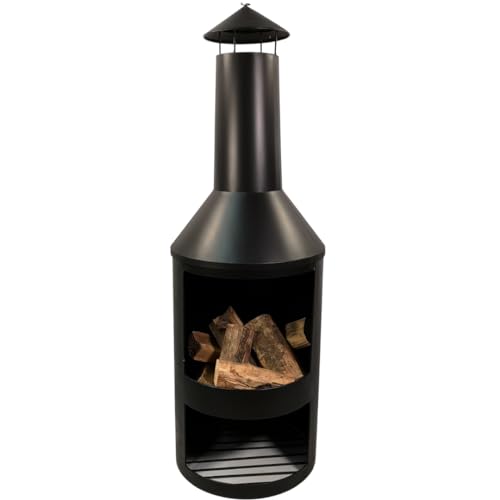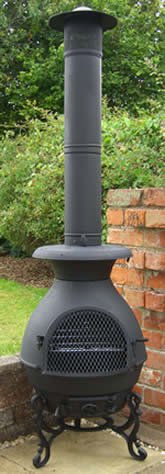What's The Job Market For Ceramic Chiminea Professionals Like?
페이지 정보

본문
 The Basics of a Ceramic Chiminea
The Basics of a Ceramic ChimineaClay is the most common material used to make chimineas. Think of terracotta pots, or red pottery. Clay is very strong and hard, but it is also susceptible to cracking if not handled properly.
 The chiminea's clay is highly absorbent and needs to be protected with sand or gravel at the bottom of the chiminea, along with logs and kindling. This protects the clay from burning too hot and seals hairline cracks.
The chiminea's clay is highly absorbent and needs to be protected with sand or gravel at the bottom of the chiminea, along with logs and kindling. This protects the clay from burning too hot and seals hairline cracks.Materials
Traditional clay chimineas, also called pot-bellied ovens, come with a chimney that directs smoke into the air. These types of chimineas are usually coated to shield them from weathering and cracking due to sudden temperature changes. They are still susceptible to sunlight and rain. This is why it is important to cover them when not in use, and to ensure that water puddles do not form within the clay.
The majority of chimineas are made of terracotta clay. Other materials like cast iron and steel could also be used. Aluminum and cast iron offer an extremely durable option that requires less maintenance. Terracotta has a classic Mexican look. Certain manufacturers offer modern designs that combine the beauty and durability of a clay-based chiminea.
Many people pair their chimineas with flowers or evergreen plants. This gives a natural appearance to complement the ambiance in their backyard. It is important to choose plant pairings carefully, though the chiminea has to be located in a place that is free of structures that can catch fire. It is also essential to make sure that the chiminea is placed on a safe surface such as brick, concrete or stone patios.
A chiminea is usually constructed by hand from high-fired clay, which might or may not be glazed. The potter is the one who creates the clay. They can employ a plaster mold or a wheel of a potter. In either case, the clay is kneaded prior to being allowed to dry. Certain newer clay chimineas are pre-grogged as an additive that helps to withstand thermal stresses that are susceptible to cracking traditional earthenware.
Other chimineas are constructed using molds made of metal which give the chimineas a variety of design and shapes to fit any backyard. Cast iron chimineas are heavier than clay models, but they are more robust and less likely to break or crack because of sudden temperature fluctuations. They are cheaper than other types of chimineas as well and are available with gas-burning models too to give you more versatility.
Styles
Chimineas are fireplaces which can be decorated in different styles and materials. Terracotta chimineas have a classic style that has been in use for centuries, whereas metal chimineas are more durable and can withstand high temperatures. A lot of chimineas come with decorative patterns and designs that enhance the patio furniture. A rustic patina finish for instance, can give a chiminea an antique style, especially when paired with wood and iron patio furniture.
Chimineas are usually designed to be freestanding, but they can also be erected on a stone, brick, or concrete patio. Whatever you decide to put your chiminea, pick a spot that is sheltered from winds and positioned away from any flammable plants or structures. It is crucial to keep in mind that chimineas release smoke and soot that can impact the air quality of the surrounding area.
Certain chimineas have an opening for the chimney at the bottom, while others are squat, with a point upwards. Both styles come with or without an opening big enough to hold firewood. The chimneys of squat models can also be shaped to add visual appeal and create a more striking appearance.
You can also add decorative elements to the exterior of your chiminea sale like wrought iron, marble, or granite. To add a touch of elegance, you might think about the option of a copper or ceramic top. These finishes reflect light and enhance the look of your chiminea.
Regular chiminea polishing is another option to beautify your fire pit outside and protect it from harm. Use a natural polishing agent like beeswax or olive oil, to buff the surface and achieve a rich shine. Apply a thin layer and rub gently after which rinse and dry the chiminea barbecue to get a stunning result.
Chimineas require a lot of maintenance, but with the right care and attention your creative outdoor chiminea can remain stylish for years to come. With the help of practical decorating strategies and maintaining your chiminea, you can enjoy it for years to come. colder months.
Safety
Although chimineas are popular but they can be dangers to safety if they are not correctly used. Chimineas made from clay are prone to cracking, especially those that aren't glazed. They also pose a fire risk if too close to other flammable materials like your home, outdoor furniture and the garden surrounding it. You should only use a chiminea outdoors and in an area that is secured or surrounded by fire-proof materials.
Keep a fire extinguisher handy you and make use of it to extinguish small fires, or hot coals, that may occur while you tend to your flame. You could also make use of a long lighter for lighting your fire, and move the coals using tongs instead of using your hands. A bucket of water is also an excellent thing to keep close by in the event that the chiminea has to be put out. It is crucial not to use water to extinguish a fire that has been chilled down and to only add water after the fire has died naturally or if a large fire is at risk of bursting into the chimney.
The draft created by a chiminea could carry sparks upward through the stack, which is why it is essential to shield your property and your neighbors from burns that could happen accidentally by using an easy spark arrestor made out of chicken wire placed around the top of the smokestack. Chimineas also produce a lot of heat and the area surrounding them can get very hot, so you should place a low wall around the chiminea in order to warn people that getting close to it could result in painful burns.
Never burn your chiminea during rainy or windy conditions. The sparks can cause a chimney to catch fire, which could cause damage to your home. Check with your local fire department if there are any burn bans in place before using the chimney. You should also clean the area around the chiminea before adding firewood, making sure there aren't any flammable materials nearby. It is also a good idea to clean the inside of your chiminea after each use in order to stop the accumulation of ash that could lead to smoke inhalation and a sooty exterior.
Maintenance
Despite the fact that they can be used for outdoor fires, clay chimineas are not maintenance-free devices. Like all things made from clay, they require being treated with a certain amount of ongoing care to guarantee their longest possible life. This means not making them too hot and taking the time to allow them to cool down between each use. In addition they should be regularly cleaned and sealed to prevent the paint from being damaged by moisture.
It is important to remove the ashes after every use of your chiminea, but only after it has completely been cooled. It will still be warm even though it appears to be cooling, so make use of a small rake and a brush to get rid of the ash. After you have carefully removed the ash and disposed of the debris the next step would be to fill the bottom of the chiminea either gravel or sand. This is crucial, as in the event that you fail to do this, the chiminea could crack. This is due to the fact that clay absorbs water and could crack if it is too dry.
Some sources recommend sealing the exterior of the chiminea using an acrylic waterproofing agent, similar to the ones used to seal tiles. This will stop moisture from causing damage to the chiminea. It is recommended that the best chiminea uk be cleaned and resealed every 6 to 8 weeks during periods of heavy usage.
Chimineas should only be burned on clean, safe surfaces. They should never be placed on wood decking or on any other type of overhead covering. Only using hardwood that is well-seasoned will decrease the amount of sparks and stop the clay from cracking.
A chiminea made of clay will not last for a long time. However, it is not a problem to break unless hit it with an extremely heavy Hammer. Cracks can occur due to a variety of reasons, including poor combustion or the lack of proper maintenance. They are also prone to rust, so they should be covered whenever not in use. This will stop snow and rain from corroding the metal components.
- 이전글20 Things You Should ASK ABOUT Mental Health Assessment Prior To Purchasing Mental Health Assessment 24.11.30
- 다음글You'll Never Guess This Timber Sash Window's Tricks 24.11.30
댓글목록
등록된 댓글이 없습니다.

